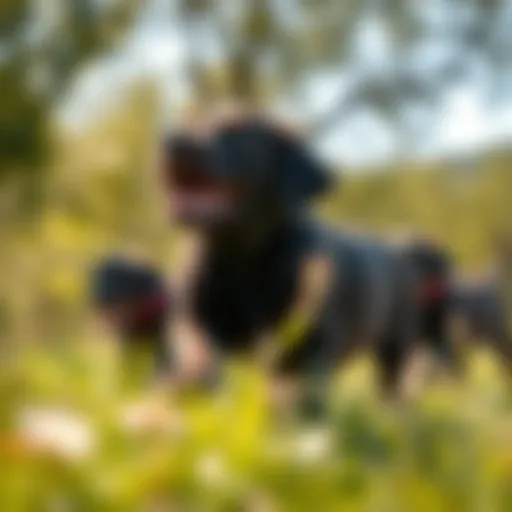Optimal Nutrition Strategies for Cat Weight Loss
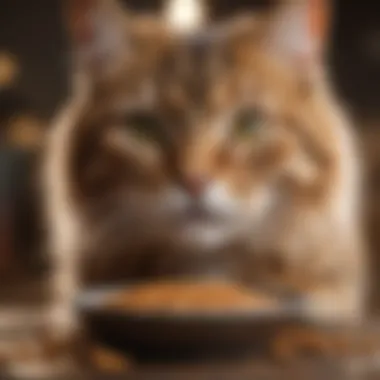

Intro
Cats experiencing weight issues form a growing concern among pet owners. Obesity in felines leads to numerous health problems. This article outlines effective dietary strategies for managing weight loss in cats. By understanding key nutrition principles, adopting proper portion control, and following veterinary guidance, owners can support their pets’ well-being.
Pet Care and Grooming
Proper cat care extends beyond just diet. Regular grooming plays a significant role in overall pet health, which includes weight management.
Importance of Regular Care
Consistent grooming aids in spotting health issues early. Regular brushing reduces shedding and prevents matting, which can be uncomfortable for your cat. It also promotes better skin health. Furthermore, a well-groomed cat is less likely to suffer from stress-related issues associated with discomfort or infections.
Grooming Techniques by Pet Type
Different breeds of cats require different grooming methods.
- Short-haired breeds like the American Shorthair need less frequent brushing, roughly once a week.
- Long-haired breeds such as the Maine Coon require daily grooming to avoid tangles and matting.
- It is essential to develop a routine suitable for your cat's specific needs.
Tools and Products Recommendations
Investing in the right tools is crucial for effective grooming. Here are some recommended utensils:
- A slicker brush for long-haired cats
- A bristle brush for short-haired breeds
- Nail clippers suitable for cats Choosing appropriate products ensures successful maintenance of your cat’s coat and claws.
Seasonal Care Tips
Cats may have different grooming needs during various seasons. In warmer months, a trim may be beneficial, while in colder months, ensure they are well-brushed to avoid excessive shedding and clumps. Monitor their skin health, as changes in temperature can affect their hydration and overall comfort.
Health and Nutrition
Nutrition is at the core of any weight loss strategy. For cats, understanding how to balance their dietary needs can significantly impact their health.
Understanding Pet Nutrition
Cats are obligate carnivores, meaning their diet must consist primarily of meat. However, many pet owners may not fully understand their cat's specific dietary needs.
- Proteins are essential for maintaining muscle mass.
- Fats provide energy, but should be limited for weight control.
- Carbohydrates can be present but should not dominate their diet. Focusing on high-quality protein sources, like real meat or fish, is critical in a weight loss program.
Common Health Issues by Species
Cat obesity can lead to conditions like diabetes, osteoarthritis, and heart disease. Regular vet check-ups are essential. Early detection can lead to better management and treatment of these conditions.
Preventive Care and Regular Check-Ups
In addition to proper diet, routine veterinary visits help monitor your cat’s health. Regular examinations can catch potential issues early, allowing for timely intervention. Vaccinations and parasite control are also essential components of preventive care.
Food and Dietary Advice
When considering weight management for your cat, consider these helpful points:
- Choose a weight management cat food specifically formulated for weight loss.
- Implement a feeding schedule to help control portion sizes.
- Always measure food portions to avoid overfeeding. Tracking caloric intake is vital for effectively managing weight.
Behavioral Training
Behavioral training can complement dietary strategies in managing a cat's weight.
Basics of Positive Reinforcement
Using positive reinforcement methods can encourage desired behaviors, such as increased physical activity. Cats respond well to rewards like treats or praise, which can motivate them to engage in play.
Training Techniques Users Can Apply
Here are some effective techniques:
- Use interactive toys to promote movement.
- Schedule play sessions at regular intervals throughout the day.
- Encourage exploration of different areas to stimulate their senses.
Managing Behavioral Issues
Stress or anxiety can lead to overeating in cats. Identifying triggers and addressing them is crucial. Creating a calm environment can help mitigate these behavioral issues.
Importance of Socialization
Socialization is key to a cat's emotional well-being. Encourage interaction with other cats or safe pets, which can help your cat stay active and mentally stimulated.
Engaging Activities and Enrichment
Incorporating engaging activities into your cat’s routine can greatly enhance their quality of life while aiding in weight management.
Fun Games to Play with Your Pet
Interactive play helps your cat burn calories. Activities like laser pointers or feather wands motivate them to chase and jump. Consider using puzzle feeders that encourage mental challenges along with physical activity.
DIY Toys and Activities
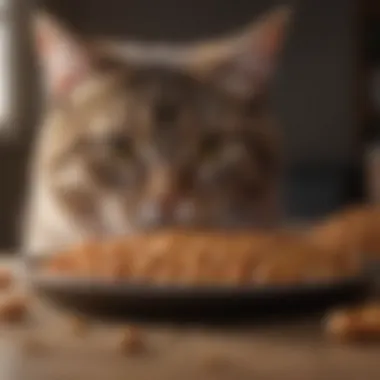

Creating DIY toys can stimulate your cat's interest without much cost. Simple items like crumpled paper or homemade scratching posts can provide entertainment and cater to their natural instincts to scratch and hunt.
Importance of Mental Stimulation
Mental stimulation is just as important as physical activity. Rotating toys and introducing new challenges can keep them engaged. A bored cat may become lethargic, leading to unhealthy weight gain.
Outdoor Adventures and Exploration
If safe to do so, allow your cat some outdoor time. Supervised walks using a harness can provide fresh air and exercise, ensuring they remain active in a controlled environment.
Resources and Community Engagement
Connecting with a community can provide additional support and resources.
Recommended Books and Websites
Consider checking sources like Wikipedia for general knowledge and Britannica for specific insights on feline health and nutrition. Online platforms often offer educational resources beneficial for pet owners.
Forums and Groups for Pet Owners
Engaging in forums on websites like Reddit allows cat owners to share experiences and advice related to weight loss strategies and dietary management.
Finding Local Services and Classes
Seek local services that might offer training classes or workshops focused on animal care. Learning from professionals can widen your understanding of effective weight management for cats.
Encouraging Community Sharing and Contributions
Encouraging sharing within your community promotes collective knowledge. Whether through local meet-up groups or social media on platforms like Facebook, sharing insights can significantly benefit cat owners.
Proper nutrition and a fulfilling lifestyle are essential for maintaining a healthy weight for your cat. Start today for a healthier and happier companion.
Understanding Feline Obesity
Feline obesity has become a prevalent issue in our society. Understanding this topic is crucial for cat owners who seek to maintain their pets' health. This section will delve into the prevalence of obesity in cats and the associated health risks, providing insights that empower owners to make informed decisions regarding their pets' diets.
The Prevalence of Obesity in Cats
Obesity is a significant concern among household cats. Studies show that around 60% of domesticated cats are overweight or obese. This condition often accelerates with age. As cats become less active, their calorie intake may not adjust accordingly, leading to weight gain.
Several factors contribute to the rising prevalence of obesity in cats. One key factor is the convenience of feeding, as many owners opt for high-calorie kibble. Additionally, indoor living can limit exercise opportunities for cats. The rapid increase in obesity rates is alarming, and understanding its prevalence better prepares owners for prevention.
Health Risks Associated with Obesity
Feline obesity is not merely a cosmetic issue; it comes with serious health implications. Some of the notable risks include:
- Diabetes Mellitus: Obesity is a leading risk factor for diabetes in cats. The body may become insulin-resistant, leading to elevated blood sugar levels.
- Joint Problems: Extra weight puts stress on a cat's joints, potentially leading to arthritis or mobility issues as they age.
- Heart Disease: Obese cats are more prone to cardiovascular issues, impacting their overall longevity and quality of life.
- Liver Disease: Fat accumulation in the liver can lead to hepatic lipidosis, a potentially life-threatening condition.
Owners must recognize these health troubles linked to obesity. A proactive approach, addressing diet and lifestyle, can greatly improve a cat's overall well-being. The importance of monitoring a cat’s weight and consulting with a veterinary professional cannot be emphasized enough. This understanding is the first step towards adopting a more effective diet plan focusing on weight loss and healthier living.
Nutritional Needs of Cats
Understanding the nutritional needs of cats is vital for their health, especially when managing weight loss. Cats are obligate carnivores, which means their diet must primarily consist of meat. They require a variety of nutrients to ensure proper bodily function. When crafting a weight loss plan, it’s essential to provide a balanced diet while meeting these nutritional needs. Failing to do so can lead to malnutrition and other health complications.
Essential Nutrients for Feline Health
Proteins
Proteins are crucial for maintaining muscle mass, especially as cats lose weight. These nutrients play a significant role in the body's structure and function. High-quality proteins can improve satiety, helping cats feel full while consuming fewer calories. An important characteristic of proteins is their essential amino acids. These are necessary because cats cannot synthesize them on their own.
However, there are some disadvantages. Too much protein can strain their kidneys, particularly in older cats or those with pre-existing conditions. Therefore, it’s essential to balance protein intake with other dietary components.
Fats
Fats are also an important part of a cat's diet, providing energy and supporting various bodily functions. They aid in the absorption of fat-soluble vitamins and play a role in maintaining healthy skin and coat. A key reason fats are beneficial in weight loss diets is that they can create a sense of fullness in cats, making them less likely to overeat.
However, excessive fat consumption can lead to weight gain rather than weight loss. Thus, it is vital to monitor the source and amount of fat included in a cat's diet, opting for healthy fats while keeping overall caloric intake in check.
Vitamins
Vitamins support numerous bodily functions and are essential for overall well-being. They assist in metabolism, immune function, and cell repair. Vitamins such as A, D, E, and K are vital in a cat’s diet. The unique aspect of vitamins is that they orchestrate cell functions and processes in the body.
On the downside, vitamins can be toxic in high doses. Over-supplementation can lead to adverse health effects, making it critical to provide them in appropriate amounts based on specific dietary needs.
Minerals
Minerals are necessary for physiological functions like bone health, nerve function, and muscle contraction. Key minerals like calcium, phosphorus, and potassium play vital roles in maintaining health. The specific aspect of minerals is their involvement in tissue growth and repair.
Similar to vitamins, too much of certain minerals, such as phosphorus and magnesium, can harm kidney function or increase the risk of urinary tract issues. It is essential to balance these nutrients within the diet.
Understanding Feline Metabolism
Feline metabolism describes how a cat processes and utilizes food for energy. Understanding this metabolic process helps cat owners tailor diets more effectively. Cats have a unique metabolic rate, often requiring higher protein intake compared to other pets. Additionally, their ability to convert protein into energy rather than carbohydrates makes it necessary to focus on nutrient-dense food choices. A deeper knowledge of metabolism can enhance your approach to weight loss and overall health for feline companions.
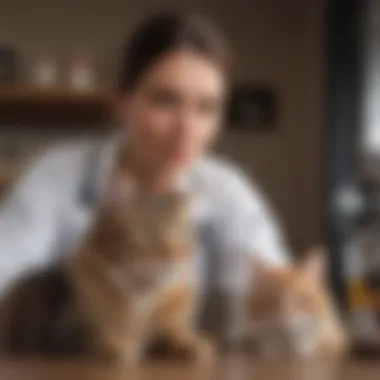

Identifying the Right Cat Food
Selecting the appropriate cat food is crucial for achieving weight loss in felines. The right food helps manage calorie intake and ensures the necessary nutrients are included. By focusing on specific elements, understanding the types of food, and interpreting labels, cat owners can make informed decisions. The benefits of identifying proper cat food are numerous, including improved health, behavioral satisfaction, and the support of a successful weight loss journey.
Types of Cat Food
Dry Food
Dry food, often less expensive and convenient, plays a role in managing a cat's weight. The low moisture content helps to prevent overfeeding, as cats tend to consume less at once. A key characteristic of dry food is its generally lower fat content, compared to canned or raw food. This can be beneficial for weight control. However, cats may not drink enough water when primarily fed dry food, which can lead to dehydration. Therefore, it’s important to monitor their water intake if this type is chosen.
Canned Food
Canned food is appealing for many reasons. Its higher moisture content contributes to better hydration, which is especially important for weight loss. This type of food often contains more protein, which supports muscle retention during weight loss. A unique feature of canned food is its palatability; many cats prefer its taste and texture, which can be advantageous for encourage eating. However, it may be denser in calories, so careful selection and portion control are vital.
Raw Food
Raw food diets are becoming more popular among cat owners. They mimic a cat's natural diet and can provide optimal nutrition. The key characteristic of raw food is its high protein content and absence of harmful fillers or artificial ingredients. As a result, this diet can support a feline's metabolic needs. One advantage is the potential for improved coat condition and overall vitality. On the downside, raw food requires careful preparation and handling to prevent bacterial contamination.
Reading and Understanding Labels
Reading pet food labels effectively is an essential skill for cat owners. Understanding what the ingredients and nutritional information signify can guide food choices during the weight loss process. Important components on the label include the guaranteed analysis, listed in order by weight, and the ingredients used. Keywords like 'grain-free' or 'high protein' indicate certain dietary characteristics that may help or hinder a cat's weight loss. By familiarizing oneself with these details, a cat owner can ensure they are choosing the right products for their pet's weight management plan.
Caloric Needs for Weight Loss
Understanding the caloric needs of cats is crucial for managing their weight loss effectively. Just as in humans, the balance of calories consumed versus calories expended plays a vital role in weight control for felines. It is essential to provide cats with the right amount of calories to ensure they are not only losing weight in a healthy manner but also receiving adequate nutrition during the process. Focusing on a calorie deficit, where the energy expenditure exceeds the calorie intake, helps in achieving weight loss goals.
Calculating Daily Caloric Intake
Calculating the daily caloric intake for a cat requires considering various factors including age, weight, activity level, and metabolic rate. Generally, a cat's maintenance calories can be estimated using an equation such as the MER (maintenance energy requirement). For instance, a typical method involves multiplying the cat's weight in kilograms by 30 and adding 70. This gives a baseline calorie amount that the cat needs to maintain its weight.
Once the maintenance needs are established, one can reduce this caloric value by a certain percentage to create a deficit suitable for weight loss. A common recommendation is to aim for a reduction of about 10-20% from the maintenance total. However, it is vital to do this cautiously, as excessive calorie restrictions can lead to serious health risks.
Role of Portion Control
Portion control is a fundamental aspect of managing a cat's diet for weight loss. Simply feeding less food may seem straightforward, but it requires careful calculation to ensure that the cat is still getting all the essential nutrients. Cats thrive on consistent feeding schedules, and determining the right portion size based on the calculated caloric intake is necessary.
Using measuring cups or food scales can help in accurately determining portion sizes. Feeding smaller, more frequent meals can also be beneficial for both weight loss and maintaining energy levels throughout the day. Here are some strategies related to portion control:
- Read serving size recommendations on food packaging: Many commercial cat foods provide guidelines that can help in managing portions effectively.
- Observe your cat's body condition: Regularly assess your cat’s body condition score to make adjustments as necessary.
- Avoid free feeding: This can lead to excessive calorie intake in many cats. Scheduled meal times help regulate food consumption.
Remember, maintaining balance in your cat's diet is as important as controlling portions. Ensuring they receive a mix of the right nutrients is key to their overall health and well-being.
By integrating both accurate caloric calculations and effective portion control strategies, cat owners can create structured meal plans that promote sustainable weight loss while keeping their pets happy and healthy.
Creating a Weight Loss Meal Plan
Establishing an appropriate meal plan is crucial for any weight loss journey. For cats, this is particularly important due to their unique dietary needs and behavioral traits. A carefully structured meal plan ensures that your cat receives the necessary nutrients without excessive calories. This not only aids in weight reduction but also supports overall health.
A weight loss meal plan should take into account the individual cat’s age, activity level, and health conditions. It is advisable to consult with a veterinarian when crafting this plan. This way, dietary choices can be tailored to specific requirements and any potential health issues can be addressed safely.
Food Selection Strategies
When selecting food for a weight loss meal plan, it is important to focus on high-quality ingredients. Look for cat foods that contain a higher protein content while being lower in carbohydrates. This balance helps maintain muscle mass while shedding fat. Here are some tips for food selection:
- Choose high-protein foods: Foods rich in protein help cats feel full and satisfied. They also support muscle preservation.
- Consider low-calorie options: Look for products labeled as “light” or “weight management”. These usually contain fewer calories but still meet nutritional needs.
- Include fiber: Foods with added fiber can help with satiety and digestion. They prevent hunger pangs between meals.
- Be cautious with treats: If you must give treats, opt for healthy, low-calorie choices and account for their calories in your daily intake.
Additionally, homemeade cat food should be considered only after careful consultation with a vet. It allows for customization, but it requires knowledge of feline nutrition.
Feeding Frequency and Schedule
The timing and frequency of meals can significantly impact a cat's weight loss. Frequent small meals throughout the day can manage hunger and aid metabolism. Here are some practical considerations:
- Regular meal times: Set a consistent feeding schedule to help regulate your cat's metabolism. This reduces the risk of overeating.
- Portion control: Use measuring cups to ensure each serving adheres to your cat's caloric needs. Avoid free-feeding, which can lead to excessive calorie intake.
- Monitor hydration: Always provide fresh and clean water. Sometimes, cats may confuse thirst with hunger, leading to unnecessary eating.
A well-structured feeding routine provides not only physical benefits but also helps in developing a stronger bond between you and your pet.
In summary, creating a targeted meal plan for weight loss involves strategic food selection and careful management of feeding practices. Such a plan promotes not just weight loss, but also overall well-being in your feline companion.
Incorporating Exercise into the Routine
Regular exercise is essential for a cat's overall health, especially when aiming for weight loss. Just like humans, cats benefit significantly from physical activity. Integrating exercise into a cat's daily routine contributes to maintaining a healthy weight, improving cardiovascular health, and enhancing mental well-being. Moreover, an active lifestyle can reduce the risk of various health problems, which is crucial for overweight cats. Therefore, understanding the types of suitable exercises and engaging playtime activities is vital for cat owners looking to promote a healthier lifestyle for their pets.
Types of Suitable Exercises
When it comes to exercise, it does not always mean a rigorous workout. Cats naturally engage in short bursts of energy followed by rest, and their exercise should reflect this behavior. Here are some suitable types of exercises:
- Walking on a leash: Training a cat to walk on a leash can be a rewarding experience. This routine can provide fresh air and new sights for your cat while encouraging walking.
- Interactive toys: Toys that require movement can encourage cats to be active. For instance, laser pointers or feather wands can stimulate a cat's hunting instincts, promoting leaps and bounds.
- Climbing structures: Cats enjoy vertical spaces, and providing cat trees or shelves can encourage climbing. This not only provides exercise but also mental stimulation, as they explore new heights.
- Fetch games: Some cats enjoy playing fetch. Using a small ball or a stuffed toy can help to train your cat to return the item, adding an element of playfulness to their routine.
Engaging Playtime Activities
Engaging your cat in playtime activities is essential for making exercise fun. Here are a few activities to consider:
- Puzzle feeders: These not only make meal times more interactive but also encourage your cat to work for their food, promoting both physical and mental exercise.
- Chasing toys: Toys that mimic prey, like moving strings or small animals, can invigorate a cat’s natural hunting instincts. Setting up a space where your cat can chase these toys will encourage physical activity.
- Scheduled play sessions: Designating specific times every day for play can give structure to your cat’s routine. Short sessions throughout the day will help maintain your cat's interest and energy levels.
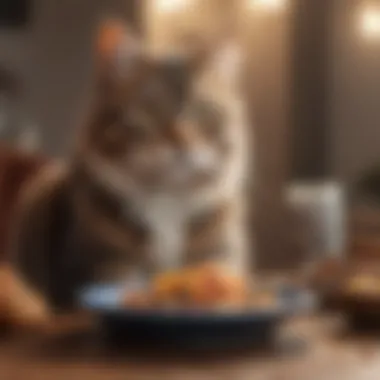

Engaging in regular exercise not only aids in weight loss but also strengthens the bond between a cat and its owner.
In summary, incorporating exercise into your cat's routine involves understanding their natural behavior and providing opportunities for physical activity. By combining various types of exercises with engaging playtime activities, cat owners can create a well-rounded routine that promotes weight loss and overall health.
Monitoring Progress and Adjustments
Monitoring the progress of your cat’s weight loss journey is crucial. It is not simply about reducing the number on the scale but ensuring the overall health of your feline companion. Observing how your cat responds to dietary changes and exercise helps in tailoring the approach to their specific needs. This section will discuss tracking weight loss, knowing when to adjust the meal plan, and the importance of regular evaluations.
Tracking Weight Loss
Keeping track of your cat's weight loss is an essential practice. Regular weigh-ins help you identify patterns and determine the effectiveness of the diet. Ideally, your cat should lose weight gradually, about 1% to 2% of their body weight per week. This slow approach minimizes the risk of health issues often related to rapid weight loss.
Best Practices for Tracking Weight
- Consistent Schedule: Weigh your cat at the same time each week, preferably under similar conditions. Morning weigh-ins before feeding can provide consistent results.
- Use a Reliable Scale: A pet scale or a regular scale will work. If using a regular scale, weigh yourself first, then weigh yourself holding your cat, and subtract the difference.
- Record Findings: Maintain a simple log to record the weight each week. This record serves as a reference for future dietary adjustments and can highlight trends over time.
- Monitor Body Condition: Weight alone doesn’t tell the full story. Evaluate your cat’s body condition score (BCS) to assess fat distribution and muscle mass. This can provide further insights into their health.
Regular monitoring can significantly enhance the weight loss success for your cat, ensuring they are not losing weight too quickly or too slowly.
When to Adjust the Meal Plan
Understanding when to alter your cat’s meal plan is a key element in sustaining effective weight loss. As your cat loses weight, their caloric requirements change. Therefore, it’s important to stay vigilant and make adjustments as necessary.
Signs Your Meal Plan Needs Adjustment
- Stagnant Weight: If your cat's weight remains unchanged for several weeks, it may indicate that their caloric intake is still too high. In this case, reducing portions or switching to lower-calorie food may be necessary.
- Consistent Weight Loss: If weight loss is consistently within the target range, continue the current meal plan. If the rate of loss picks up speed or becomes too slow, consider a reassessment.
- Behavioral Changes: Increased hunger or lethargy may signal that a change is needed. If your cat seems excessively hungry or loses interest in meals, consult with a vet for advice on adjusting calorie intake.
- Physical Appearance: Monitor changes in your cat’s physical appearance. If they start losing muscle mass or developing excessive skin folds, adjustments may be needed.
In summary, careful monitoring and timely adjustments to your cat's diet are crucial elements of any weight loss plan. This proactive approach not only assists in managing weight but also promotes a healthier and happier life for your feline friend.
Consulting Veterinary Professionals
Importance of Professional Guidance
When it comes to managing a cat's weight, consulting veterinary professionals is crucial. These experts have the knowledge and experience to evaluate a cat’s specific health needs. They can provide tailored dietary recommendations based on the cat’s age, breed, and any existing health condition. A veterinarian will assess factors such as current weight, activity level, and lifestyle, offering insights that help create an effective weight loss strategy.
Professional guidance also helps in avoiding common pitfalls. Many cat owners may mistakenly assume that all diet foods are beneficial or could rely on anecdotal evidence from fellow pet owners. This can lead to improper feeding practices that may not support optimal health. Consulting a vet ensures that the diet aligns with professional standards, minimizing risks associated with poor nutrition.
Additionally, veterinarians can suggest supplements or specific food brands like Hill's Prescription Diet and Royal Canin, which are scientifically formulated for weight management in felines. They can also recommend alternatives that suit a cat's specific taste preferences and nutritional needs. This personalized approach can make the weight loss journey much more effective and sustainable.
Regular Health Check-Ups
Routine visits to the veterinarian are an essential part of ensuring a cat's health during its weight loss journey. Regular health check-ups are not just for diagnosing illnesses; they also play an important role in monitoring weight and overall health. During these visits, a veterinarian can track progress, using precise measurements to evaluate weight loss and assess body condition score.
These health check-ups allow for adjusting dietary plans as necessary. If a cat is not achieving the desired weight loss, the veterinarian can modify the meal plan or recommend different types of foods. They can evaluate the effectiveness of the current strategy, ensuring it remains aligned with the cat's health needs. Furthermore, these appointments provide an opportunity to assess other health indicators, such as dental health and joint condition, which can be affected by obesity.
Regular veterinary visits help prevent potential health complications, ensuring that the dietary approach remains safe and beneficial for the cat.
In summary, consulting veterinary professionals is an indispensable step when focusing on a cat's weight management. It not only empowers pet owners with knowledge but also creates a structured path toward achieving optimal health for their feline companions.
Common Misconceptions About Cat Diets
Understanding the misconceptions surrounding cat diets is crucial for helping pet owners make informed choices. Many of these misunderstandings can lead to poor feeding practices, ultimately affecting the health of felines. By addressing these misperceptions, the article aims to clarify some of the common myths that can influence dietary habits. This section will focus on two primary misconceptions: the debate between high-protein versus low-carbohydrate diets and the myths surrounding wet and dry food.
High-Protein vs.
Low-Carbohydrate Diets
The argument about whether cats should be on a high-protein versus low-carbohydrate diet often arises in discussions regarding feline nutrition. Some cat owners believe that a high-protein diet is the key to weight management and overall health. Indeed, cats are obligate carnivores, meaning their bodies are naturally adapted to metabolize protein efficiently. However, the needs of individual cats may differ based on factors such as age, health conditions, and their level of physical activity.
While protein is essential, excessive amounts might not always lead to better health. A balanced diet should include moderate protein levels alongside healthy fats and limited carbohydrates. It's vital to recognize that carbohydrates can play a role in a cat's diet as well. Generally, carbs should not dominate the diet but can provide energy when consumed in proper amounts. Therefore, instead of strictly adhering to a high-protein or low-carbohydrate regimen, focusing on providing a well-rounded, high-quality diet suitable for a cat's specific requirements is preferable.
Myths Surrounding Wet vs.
Dry Food
There is often a debate among cat owners about the merits of wet versus dry food. One common myth is that wet food is always superior to dry food. While wet food has advantages, including higher moisture content and palatability, it isn’t necessarily the best option for all cats. Some cats prefer dry food and might not hydrate adequately if their diet consists solely of wet food.
Another often overlooked point is that dry food can support dental health as it may not adhere to teeth as much as wet food, potentially helping to reduce plaque formation. However, it's crucial to select high-quality dry food with a balanced nutritional profile.
In truth, many opinions exist about the advantages and disadvantages of both wet and dry food. An effective strategy may involve a combination of both types while monitoring the cat's health and adjusting the diet accordingly. This compromise can offer the best of both worlds, ensuring hydration and nutritional balance.
Clarifying these misconceptions aids in educating cat owners about suitable dietary choices, ultimately promoting better health for their pets.
End
Recap of Key Strategies
To summarize the key strategies highlighted throughout the article:
- Nutritional Needs: Focus on high-quality proteins while managing fat content.
- Portion Control: Accurate measurement of daily food servings is crucial. Adhering to portion sizes helps avoid overfeeding.
- Regular Monitoring: Weigh your cat regularly and assess their body condition score to track progress effectively.
- Veterinary Guidance: Consulting with a veterinarian ensures the diet plan is suitable and safe for specific health issues.
These strategies work synergistically to promote a healthier weight for cats, boosting their overall well-being.
Encouraging a Healthy Lifestyle
A healthy lifestyle for cats goes beyond just food; it involves creating an environment that supports active living. Engaging pets in regular exercise and mental stimulation is important. Activities like interactive toys and regular playtime can significantly impact a cat's physical condition and their overall mental health.
- Consistent Exercise: Implementing a routine of daily play helps burn calories, maintaining an ideal weight over time.
- Interactive Feeding: Using puzzle feeders can slow down eating and promote active engagement during meals.
- Regular Vet Visits: Keeping up with veterinary check-ups helps in preventing obesity-related health problems.
In summary, encouraging a healthy lifestyle fosters a balanced approach to weight management for cats, enhancing both longevity and quality of life.





